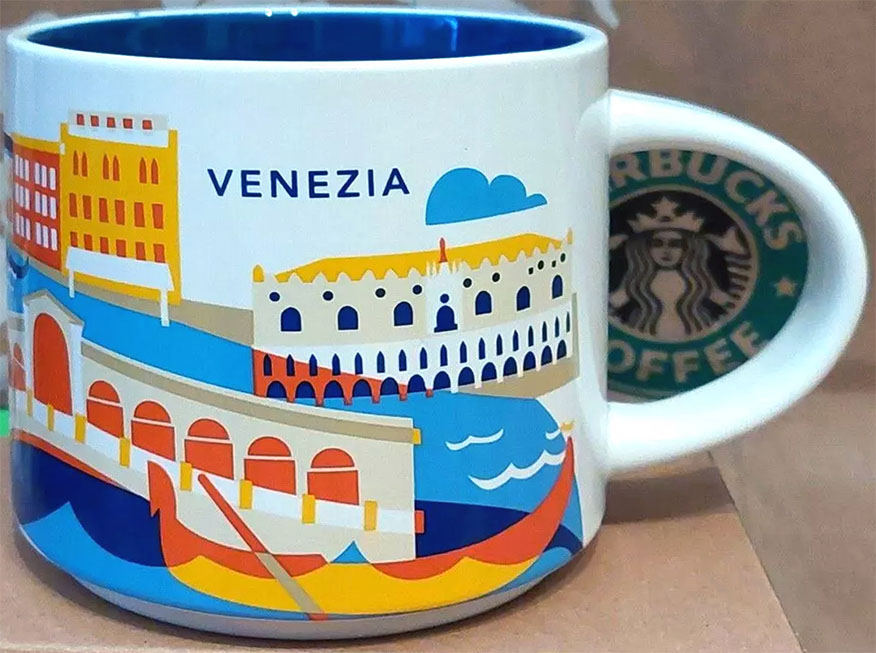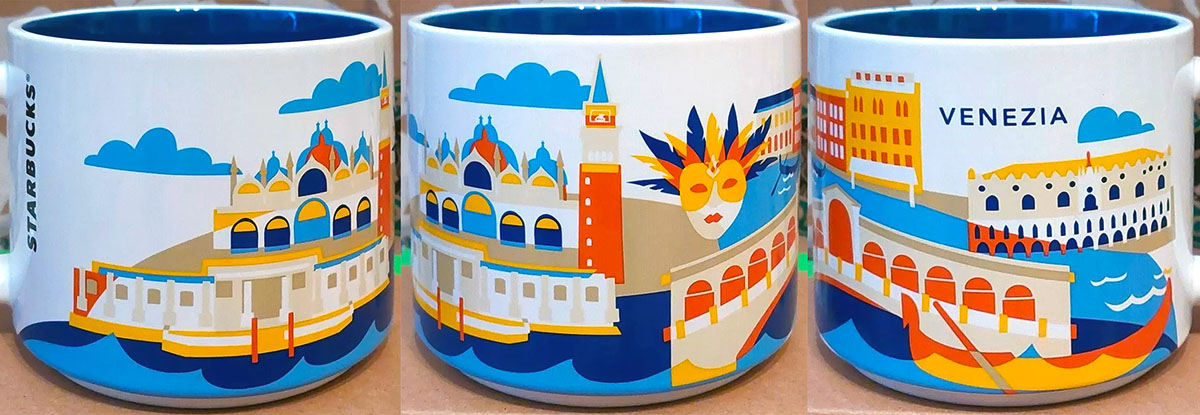
You Are Here – Venezia
Starbucks You Are Here Venezia is a mug for a well-known city in northeastern Italy that emerged from a unique historical melting pot. Founded in the 5th century by mainland residents fleeing barbarian invasions, Venice began as a series of lagoon settlements that gradually developed into a powerful maritime republic. By the Middle Ages, the city had transformed into a dominant naval and commercial power, controlling extensive trade routes between Europe and the Byzantine Empire. The Venetian Republic, which lasted for over a thousand years until 1797, was renowned for its sophisticated political system, intricate diplomatic networks, and extraordinary wealth generated through maritime commerce. Its strategic location allowed Venice to become a crucial crossroads of cultural exchange, where merchants, artists, and travelers from diverse regions converged, creating a cosmopolitan environment that fostered remarkable artistic and architectural achievements. During the Renaissance, Venice reached its zenith, producing extraordinary art, supporting influential painters like Titian and Tintoretto, and constructing magnificent structures such as the Doge’s Palace and St. Mark’s Basilica that still define its iconic cityscape today.
As you probably know, Venice is built on a remarkable network of 118 small islands nestled within the shallow Adriatic lagoon, creating an extraordinary urban landscape that defies conventional city planning. Instead of roads, Venice is crisscrossed by over 400 bridges and countless canals, where boats and traditional gondolas serve as the primary means of transportation. The city’s very foundations are a testament to human ingenuity, with buildings resting on millions of wooden piles driven deep into the marshy ground, a construction technique that has allowed this magical city to rise and persist for centuries despite the constant challenge of water. This unique aquatic environment not only shapes Venice’s physical structure but also defines its soul, making it a place where architecture, water, and human life are inextricably and beautifully intertwined.
Here are some of the most visited landmarks in Venice:
– St. Mark’s Basilica (Basilica di San Marco): this stunning Byzantine church stands as Venice’s most famous religious landmark, adorned with shimmering golden mosaics that cover over 85,000 square feet of its domes and walls. The interior is breathtaking, with its gilded ceilings, precious stones, and the famous Pala d’Oro altarpiece, making it one of the finest examples of Italo-Byzantine architecture in the world.
– The Doge’s Palace (Palazzo Ducale) served as both the residence of Venice’s rulers and the center of the city’s political power for centuries, showcasing the republic’s immense wealth and sophistication. Its distinctive pink and white marble facade, with its Gothic arches and intricate stonework, creates one of the most photographed views in Venice, especially when seen from the water.
– Rialto Bridge (Ponte di Rialto), completed in 1591, is the oldest and most famous of the four bridges spanning Venice’s Grand Canal, representing a masterpiece of Renaissance engineering. Its bold single-arch design supports a busy thoroughfare of shops and pedestrians, offering spectacular views of the Grand Canal below.
– The Grand Canal, shaped like a reverse letter S, serves as Venice’s main aquatic thoroughfare and has been called the most beautiful street in the world. Historic palazzos line both sides of the canal, showcasing the city’s architectural evolution from Byzantine through Gothic, Renaissance, and Baroque styles.
– St. Mark’s Square (Piazza San Marco), called “the drawing room of Europe” by Napoleon, represents the heart of Venice and its only true piazza. The square is surrounded by some of the city’s most important buildings, including the Basilica, the Campanile (bell tower), and the elegant colonnaded arcade of the Procuratie.
– The Venice Carnival (Carnevale di Venezia) is one of the world’s most enchanting festivals, transforming the city into a magical open-air theater each year before Lent. Dating back to the 13th century, the Carnival is famous for its elaborate masks and costumes, including the iconic Bauta, Plague Doctor, and Colombina masks, which historically allowed Venetians to move through society anonymously regardless of social class. Today’s celebration features spectacular events like the Flight of the Angel from St. Mark’s Campanile, grand masked balls in historic palazzos, and beautiful boat parades along the Grand Canal, attracting hundreds of thousands of visitors who come to experience the extraordinary atmosphere of masked figures posing against Venice’s stunning architectural backdrop.



















































































How interesting as there are no Starbucks in Venice. Are there other examples of YAH mugs for cities where you can’t even buy the mugs in a store in that city?
There is actually a store in Venice.
https://maps.app.goo.gl/uiqYzGv17CZt3eBJA